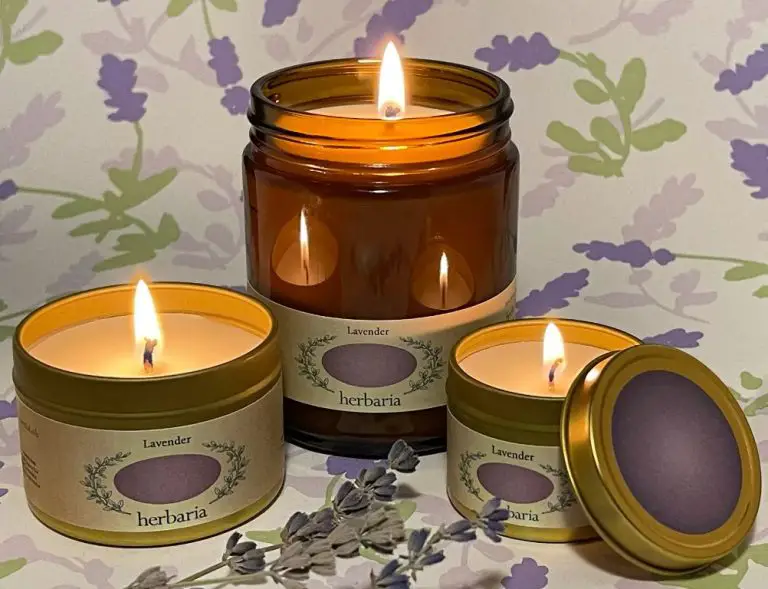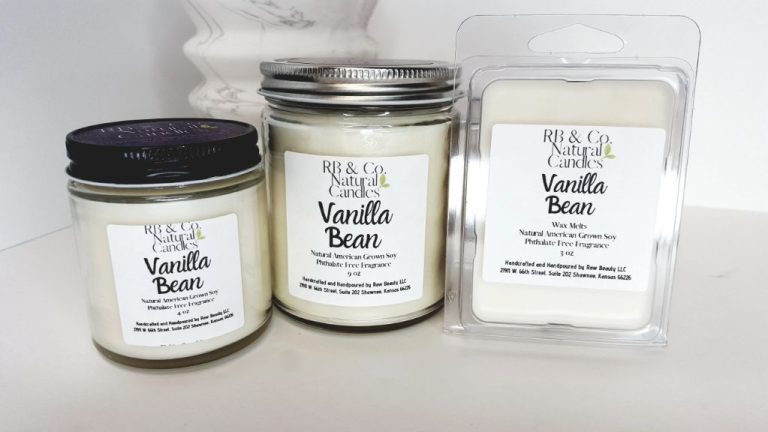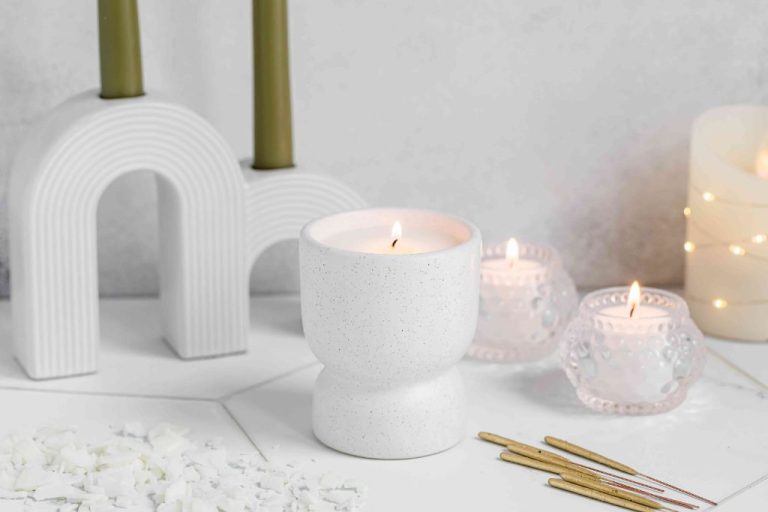What Is Natural Scented Candles?
What are natural scented candles?
Natural scented candles are candles made with natural waxes and essential oils rather than synthetic ingredients. The key components that make a candle “natural” include:
- Natural Waxes – Beeswax, soy, coconut, palm, or other plant-based waxes rather than paraffin (a petroleum byproduct). Natural waxes are biodegradable and renewable.
- Natural Scents – Essential oils, absolutes, CO2 extracts, and other natural ingredients from plants. Synthetic fragrances typically contain phthalates and other chemicals.
- Natural Wicks – Unbleached cotton or wood wicks versus lead or zinc core wicks.
- Natural Coloring – Plant dyes and minerals versus synthetic FD&C colors.
In contrast, many mass-produced candles use paraffin wax, synthetic fragrances, artificial dyes, and metal-core wicks. While cheaper, these ingredients can emit volatile organic compounds and be less environmentally friendly. Natural scented candles aim to provide an eco-conscious, non-toxic alternative.
Overall, natural scented candles use biodegradable, renewable ingredients to provide pleasant aromas in a more sustainable, chemical-free way compared to synthetic candles. They capture the essence of plants through ethical extraction processes. When sourced and produced responsibly, they can be better for people and planet.
History of Candlemaking
The origins of candlemaking date back to ancient times. Archaeologists have found evidence that primitive candles were made out of animal fat as early as 3000 BC in places like Egypt and Crete. The Egyptians soaked papyrus in melted tallow or beeswax to create simple wicks which they then lit for light. The Ancient Romans are credited with developing true dipped candles made from tallow beginning around 500 BC. They would repeatedly dip wicks into melted tallow until the candles were an adequate thickness.
Candlemaking further developed in the Middle Ages between 500-1500 AD in Europe. Candles were mainly made from tallow (beef or mutton fat) and beeswax which was expensive and only accessible to the wealthy. The growth of Catholicism increased the demand for candles used in ceremonies and to represent spirituality. By the 13th century, candlemaking had become a guild craft with regulations and standards. The first candle molds were introduced, replacing hand-dipping with a more efficient production method.1
Colonial Americans relied on candlemaking to provide light. Tallow candles were standard, while beeswax and spermaceti (from sperm whales) were higher quality but expensive. Candlemaking was primarily a craft practiced at home by women. The colonies’ thriving whaling industry provided abundant sperm oil to produce spermaceti candles. In the 18th century, spermaceti joined beeswax as luxury candles signifying wealth.2
How Natural Scented Candles are Made
The basic ingredients in natural scented candles include wax, wicks, and fragrance oils. Beeswax and soy wax are commonly used as natural wax options. Beeswax comes from honeybee hives and soy wax is made from soybeans. These natural waxes burn cleanly and are non-toxic [1]. The wick is typically made of natural fibers like cotton that bring the melted wax up to the tip to burn and release fragrance. Fragrance oils are added for scent and are made from natural essential oils like lavender, citrus, pine, etc. Unlike synthetic fragrances, natural essential oils do not contain harmful chemicals [2].

To make natural candles, the wax is first melted down and any desired additives like coconut oil or beeswax are blended in. Once the wax is fully melted and blended, the wicks are secured straight down the center of the jar or mold. The fragrance oil is added last at the recommended dosage. The wax can then be carefully poured into the waiting jars or molds. As the wax cools and hardens it will hold the wick in place [3]. Properly mixing the wax, selecting the right wick, and using the ideal amount of fragrance oil are key steps when crafting natural scented candles.
[1] https://www.thehealthymaven.com/homemade-aromatherapy-candles/
[2] https://nestingwithgrace.com/easiest-way-to-make-candles-non-toxic/
[3] https://www.100daysofrealfood.com/homemade-candles/
Benefits of Natural Scented Candles
Some of the top benefits of using natural scented candles include their ability to promote relaxation, their safety over synthetic candles, and their environmental friendliness.
The fragrances from natural essential oils used in candles can help reduce stress and create a calm environment. Studies have shown scents like lavender and chamomile can lower heart rate and blood pressure (Source).
Natural scented candles made with vegetable wax and essential oils are also safer options compared to those made from paraffin wax or synthetic fragrances, which can emit volatile organic compounds into the air. Natural candles made from soy, beeswax or coconut wax burn cleaner (Source).
Finally, natural scented candles are more environmentally friendly as they rely on renewable resources like plants and vegetable-based waxes. This makes them a more sustainable choice over petroleum-based paraffin wax.
Types of Natural Scents
Natural scented candles come in a wide variety of fragrance types. The most popular types of scents are:
Floral Scents
Floral scents like rose, jasmine, lavender, and lilac capture the sweet aroma of flowers. They provide a soft, delicate, and romantic ambiance.
Herbaceous Scents
Herbaceous scents like sage, basil, mint, and thyme offer an earthy, aromatic botanical fragrance. They have a refreshing and cleansing effect.
Fruity Scents
Fruity scents like citrus, berry, peach, mango, and apple provide a bright, tart, and sweet fruity aroma. They smell fresh and vibrant.
Spicy Scents
Spicy scents like cinnamon, clove, nutmeg, and vanilla offer a warm, cozy, bakery-like fragrance. They smell rich, comforting, and soothing.
Earthy Scents
Earthy scents like pine, cedar, sandalwood, and musk provide an outdoorsy, woodsy fragrance. They have a grounding, calming, natural aroma.
Choosing the Right Scent
When selecting a natural scented candle, it’s important to choose a scent that matches your mood, the time of day, or the season. The scent you choose can greatly impact your overall experience with the candle.
For a relaxing mood, lavender, chamomile, and other floral or herbal scents are calming options. Citrus or ocean breezes work well for an uplifting aroma. Warm notes like vanilla, cinnamon, and woodsy scents promote coziness. https://goosecreekcandle.com/blogs/candle-blog/tips-on-choosing-a-candle-scent-for-a-gift
Consider lighting clean, bright scents like lemongrass or grapefruit in the morning. Save warmer, heavier aromas like amber, sandalwood, or pumpkin for the evening.
Seasonally, floral and fruit scents match spring and summer, while fall and winter call for spicy, woodsy, or gourmand options. Ocean breezes are refreshing in hot weather, and pine or cranberry feel festive for the holidays. https://jirehhomecollection.com/blogs/news/how-to-choose-the-right-candle-scent-for-you-and-your-home
Take your time smelling different scented candles to find the perfect match for any mood or occasion.
Safety Tips
When burning natural scented candles, it’s important to follow basic safety precautions to prevent fires and other hazards. Here are some key tips:
Proper wick trimming – Trim the wick to 1⁄4 inch before lighting to prevent large flames. Long wicks create more soot and smoke. Trim the wick before each use.
Safe placement – Place candles on stable, heat-resistant surfaces away from anything flammable like curtains or furniture. Leave space between multiple candles. Avoid drafts that can cause rapid melting.
Follow burning time limits – Extinguish pillar candles when 2 inches of wax remains, and container candles when 1⁄2 inch remains. The last bit of wax can get very hot. Don’t burn candles more than 4 hours.
Following basic safety rules like these will help ensure you enjoy natural scented candles without risk of hazards. Always supervise candles when lit, and extinguish them before leaving a room. Take precautions to burn candles safely.
Top Natural Scented Candle Brands
With the rise in popularity of natural scented candles, there are now many excellent brands to choose from. Here are some of the top natural candle brands and their notable scents:
Yankee Candle
One of the most well-known candle brands, Yankee Candle offers a wide selection of natural scented candles. Their top natural scents include:
- Lilac Blossoms – A floral, fresh lilac scent.
- Beach Walk – Smells like a tropical beach with notes of coconut, palm leaves, and ocean air.
- Pink Sands – A bright, fruity blend with notes of wild strawberries and sparkling citrus.
WoodWick Candles
WoodWick is known for their wooden wicks that crackle while burning. Their most popular natural scents are:
- Hazelnut Cream – Rich, sweet hazelnut and vanilla.
- Moso Bamboo – Fresh, green bamboo with jasmine undertones.
- Honeysuckle – A floral bouquet of honeysuckle, jasmine, and lilac.
Nest Fragrances
Nest scents are inspired by artistic locations around the world. Top natural scents include:
- Sicilian Tangerine – Zesty tangerine and bergamot citrus.
- Moroccan Amber – Warm, rich amber blended with sweet florals.
- Midnight Fleur – Exotic patchouli with sensual florals.
With so many wonderful natural scented candles now available, it’s easy to find a perfect scent for your home.
Making Your Own Natural Scented Candles
Making your own natural scented candles at home has many benefits. First, you can customize the scents to your personal preferences. Second, you know exactly what is going into the candles since you choose the ingredients. Finally, it can be a fun DIY project.
The basic steps for making natural candles at home are:
- Gather ingredients – Beeswax is a popular natural wax choice. You’ll also need wax melt pots, wicks, jars, and essential oils for fragrance (https://www.thehealthymaven.com/homemade-aromatherapy-candles/).
- Melt the wax – Place beeswax pellets in a melt pot on low heat until fully melted (https://nestingwithgrace.com/easiest-way-to-make-candles-non-toxic/). Some recipes also incorporate coconut oil for an extra smooth wax.
- Add fragrance – Once wax is melted, remove from heat. Add 15-20 drops of essential oils per pound of wax and stir well.
- Pour into containers – Carefully pour the scented wax into jars or other candle containers.
- Insert wicks – Place wicks in the center of the containers before the wax fully hardens.
- Cool completely – Allow the candles to fully harden and cure for 24-48 hours.
Some tips for best results include: Using a thermometer so wax doesn’t overheat, pouring at the right temperature, and allowing enough cure time. Making your own candles takes some trial and error, but it’s a rewarding hobby!
The Future of Natural Candles
The natural scented candle market is expected to see strong growth in the coming years. According to Grand View Research, the global scented candles market is projected to reach $764.2 million by 2030, growing at a CAGR of 4.1% from 2023-2030.
Some key trends shaping the future of natural scented candles include:
- Increasing demand for natural and organic candles – Customers are becoming more concerned about ingredients and are seeking out candles made with natural vegetable waxes, essential oils, and cotton wicks. Brands like Voluspa and Bridgewater Candle Co. are responding to this demand.
- Focus on sustainability and eco-consciousness – Consumers want to reduce their environmental impact. Natural soy and beeswax candles are biodegradable options. Brands are also using recyclable packaging.
- More niche and unique scents – Brands are moving beyond basic scents and offering sophisticated luxury fragrances like leather, tobacco, and exotic florals. Diptyque and Jo Malone London lead in artisanal scent innovation.
- Men’s scented candles – Candles are no longer just for women. Brands now market masculine scents like cedarwood, vetiver, and sandalwood to male consumers.
- Increased e-commerce availability – Online shopping makes natural candle brands accessible to more consumers. Customers can easily discover and purchase artisanal brands.
- Experiential retail – Stores are creating engaging experiences around candles with scent exploration, customization stations, workshops, etc.
While some challenges exist around supply chain costs and pricing pressures, analysts remain bullish on natural scented candles. Ethics and quality are now priorities for consumers, signaling growth for sustainably-sourced, artisanal candle brands.





